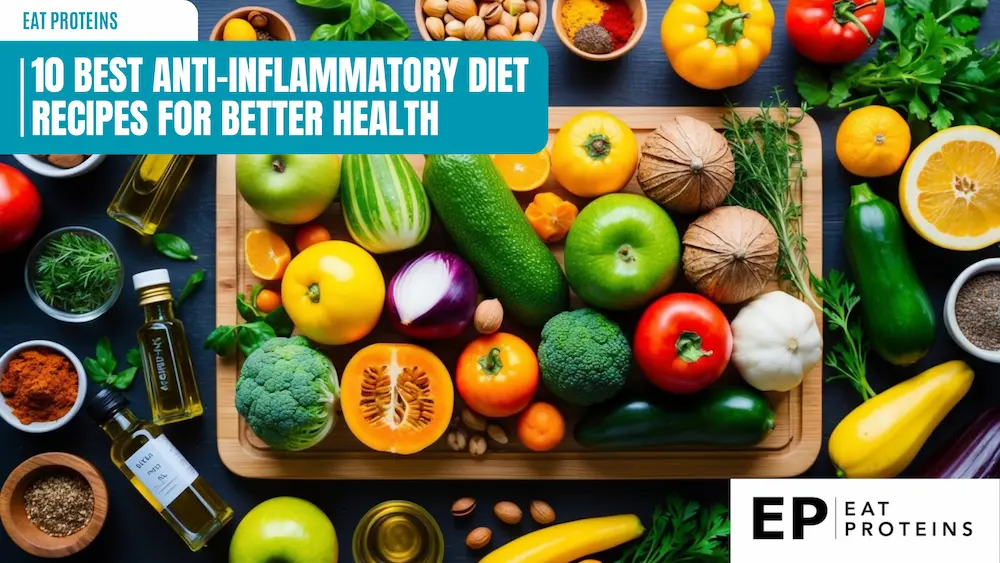
An anti-inflammatory diet can play a significant role in improving overall health and well-being. Many people face issues like chronic pain, fatigue, or digestive problems, and diet can be a key factor in managing these conditions. I believe that incorporating the right recipes can make a real difference in reducing inflammation and enhancing daily life.
In this article, I will share some of the best anti-inflammatory diet recipes that are not only delicious but also easy to prepare. These recipes focus on wholesome ingredients that support better digestion and overall health. By adding these meals to my routine, I can help fight inflammation and promote a healthier lifestyle.
1. Turmeric Ginger Lemonade

Turmeric Ginger Lemonade is a refreshing drink that combines the health benefits of turmeric and ginger. Both of these ingredients are known for their anti-inflammatory properties. This drink is easy to make and can be enjoyed any time.
To prepare this lemonade, I start by gathering my ingredients: 1 teaspoon of ground turmeric, 1 teaspoon of grated ginger, the juice of 1 lemon, 2 tablespoons of honey or maple syrup, and 4 cups of water.
Here are the simple steps:
- In a pitcher, I mix the water with ginger, turmeric, and lemon juice.
- I stir in honey or maple syrup until it dissolves completely.
- Then, I refrigerate it for about 30 minutes to enhance the flavors.
- Finally, I serve it over ice for a cool, invigorating drink.
This drink not only tastes great but also provides a simple way to include anti-inflammatory ingredients in my diet.
2. Salmon Avocado Salad
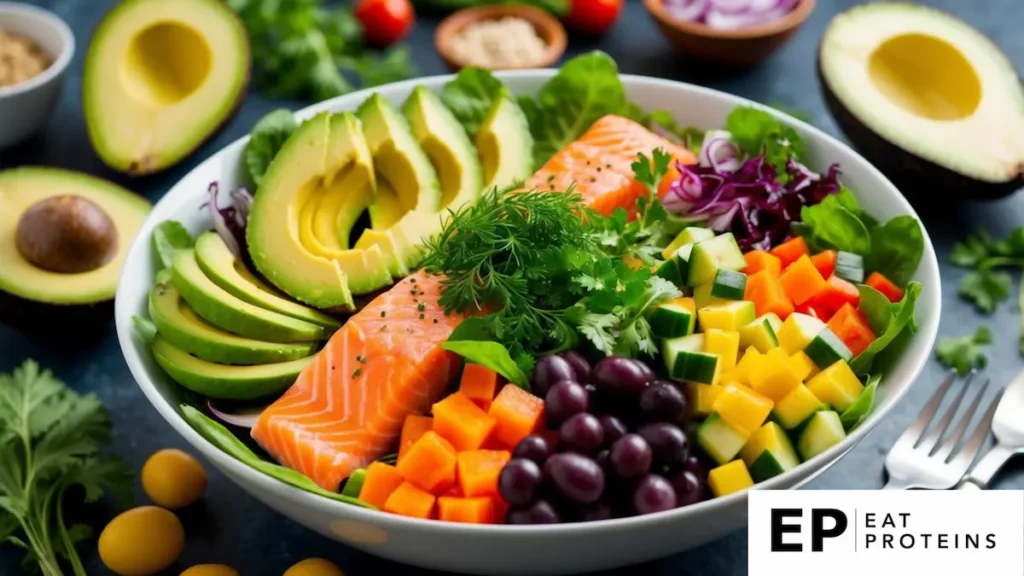
Salmon avocado salad is a nutritious dish known for its anti-inflammatory properties. Salmon is rich in omega-3 fatty acids, while avocados offer healthy fats that support overall wellness. This salad is easy to prepare and can be a delicious addition to any meal.
To make this salad, gather the following ingredients: 1 can of wild-caught salmon, 1 ripe avocado, 2 cups mixed greens, 1 tablespoon olive oil, and a squeeze of lemon juice.
Here are the simple steps to prepare it:
- Drain the salmon and place it in a bowl.
- Cut the avocado in half, remove the pit, and scoop the flesh into the bowl with the salmon.
- Add the mixed greens and drizzle with olive oil and lemon juice.
- Gently mix everything together until combined.
This salad is not only quick to make but also versatile. I can enjoy it as a main dish or a side. It provides a great balance of flavors and nutrients, making it a perfect choice for an anti-inflammatory diet.
3. Blueberry Walnut Smoothie
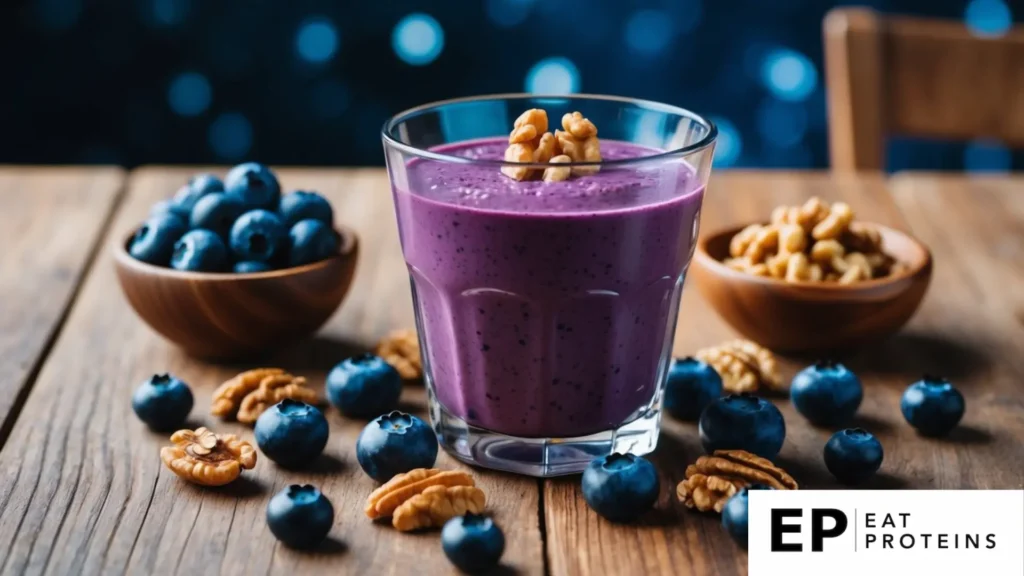
The Blueberry Walnut Smoothie is a delicious drink packed with nutrients. Blueberries are known for their antioxidants, while walnuts provide healthy fats. Together, they create a great option for reducing inflammation.
Making this smoothie is easy and quick. I can prepare it in just a few minutes. Here are the simple steps:
- Gather the ingredients: 1 cup of fresh or frozen blueberries, 1/2 cup of walnuts, 1 cup of unsweetened almond milk, and 1 tablespoon of honey (optional).
- Add the blueberries and walnuts to a blender.
- Pour in the almond milk and honey, if using.
- Blend until smooth and creamy.
This smoothie is great for breakfast or a snack. I enjoy it knowing I’m fueling my body with healthy ingredients that support my wellness goals.
4. Kale and Quinoa Bowl
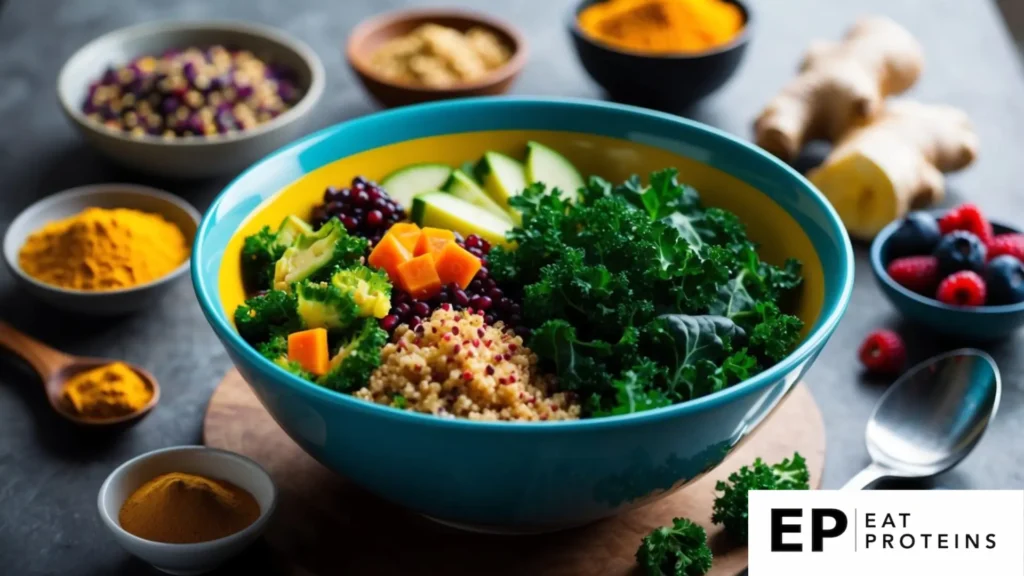
The Kale and Quinoa Bowl is a nutritious dish that combines the health benefits of kale and quinoa. Kale is rich in vitamins and antioxidants, while quinoa provides protein and fiber. This bowl is easy to prepare and can be a filling meal.
To make the bowl, gather these ingredients:
- 1 cup of quinoa
- 2 cups of water
- 2 cups of chopped kale
- 1 tablespoon of olive oil
- Salt and pepper to taste
Cooking is simple. First, rinse the quinoa under cold water. Next, bring 2 cups of water to a boil in a pot. Add the quinoa, reduce the heat, and let it simmer for about 15 minutes or until the water is absorbed.
Meanwhile, in a separate pan, heat the olive oil over medium heat. Add the kale and sauté for about 5 minutes, until it is wilted. Season with salt and pepper to taste.
Once the quinoa is cooked, fluff it with a fork and mix it with the sautéed kale. This dish can be enjoyed warm or cold. It’s a quick and healthy option for lunch or dinner.
5. Spicy Chickpea Wraps

Spicy Chickpea Wraps are a tasty and healthy meal. Chickpeas are a great source of protein and have anti-inflammatory properties. This recipe is simple and quick to make.
To prepare these wraps, I start with the following ingredients:
- 1 can of chickpeas, rinsed and drained.
- 1 tablespoon of olive oil.
- 1 teaspoon of paprika.
- 1 teaspoon of cumin.
- Salt and pepper to taste.
- Whole wheat wraps and fresh greens.
Next, I heat olive oil in a pan over medium heat. I add the chickpeas, paprika, cumin, salt, and pepper. I sauté for about 5-7 minutes until the chickpeas are warm.
While the chickpeas cook, I prepare the wraps. I place greens on each wrap and then spoon the chickpea mixture on top. I can add extra toppings like avocado or salsa if desired.
Finally, I roll the wraps tightly and enjoy a nutritious meal that is easy to make and packed with flavor.
6. Sweet Potato Black Bean Chili

Sweet Potato Black Bean Chili is a nutritious dish packed with flavor and anti-inflammatory benefits. Sweet potatoes are high in vitamins and fiber, while black beans provide protein and essential nutrients.
Making this chili is quite easy. I can prepare it in about 30 minutes, making it a perfect weeknight meal.
Here are the steps I follow:
- Dice 1 large onion and 2 cloves of garlic.
- Heat 2 tablespoons of olive oil in a pot over medium heat.
- Sauté the onion and garlic until soft, about 5 minutes.
- Add 1 chopped sweet potato (about 2 cups) and cook for 5 more minutes.
- Stir in 1 can of black beans (drained), 1 can of diced tomatoes, and 2 cups of vegetable broth.
- Season with 1 teaspoon of chili powder, 1 teaspoon of cumin, and salt to taste.
- Simmer for 20 minutes until the sweet potatoes are tender.
This dish is delicious and can be topped with avocado or fresh cilantro for added flavor. I often enjoy it with whole grain bread or brown rice.
7. Green Tea Poached Chicken
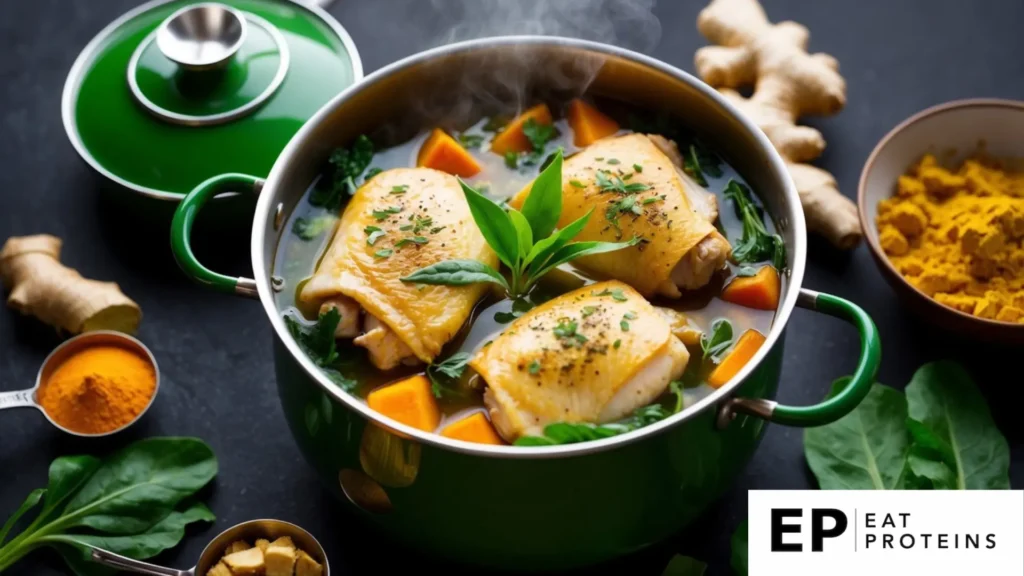
Green tea poached chicken is a healthy dish that combines lean protein with the benefits of green tea. The antioxidants in green tea can help reduce inflammation and support overall health.
I find this meal easy to make and perfect for any time of day. The cooking process is straightforward and quick, making it a great option for a busy schedule.
To prepare, follow these simple steps:
- Start by boiling 2 cups of water in a pot.
- Add 2 green tea bags and let them steep for about 3 minutes.
- Remove the tea bags and add salt and pepper to taste.
- Place 2 chicken breasts into the pot.
- Cover and simmer for about 15 minutes, or until the chicken is fully cooked.
- Remove the chicken and let it rest for a few minutes before slicing.
This dish pairs well with steamed vegetables or a fresh salad. Enjoy the light flavor and added health benefits!
8. Beet and Arugula Salad
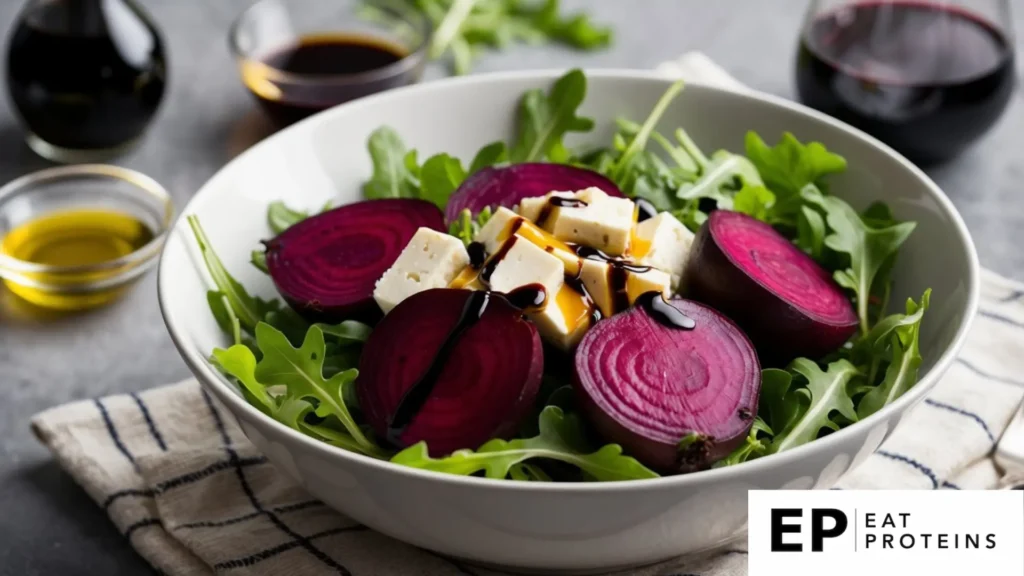
Beet and arugula salad is a nutritious dish packed with flavor. Beets are known for their vibrant color and are rich in beneficial nutrients. Arugula adds a peppery taste, making this salad refreshing.
Making this salad is easy and requires minimal preparation. I find it a delightful option for lunch or as a side dish.
Here are the steps to prepare it:
- Ingredients: Gather 2 medium beets, 2 cups of washed arugula, 1/4 cup of feta cheese, and a simple dressing of olive oil and balsamic vinegar.
- Cook the Beets: Preheat the oven to 400°F (200°C). Wrap the beets in foil. Roast them for about 45-60 minutes until tender.
- Slice the Beets: Once cooled, peel and slice the beets into wedges.
- Mix the Salad: In a bowl, combine the arugula and sliced beets. Crumble the feta cheese on top.
- Dress the Salad: Drizzle with olive oil and balsamic vinegar. Toss gently to combine.
This salad is not only quick to make but also brings a nice balance of flavors to any meal. Enjoy its health benefits as part of an anti-inflammatory diet.
9. Turmeric Cauliflower Rice
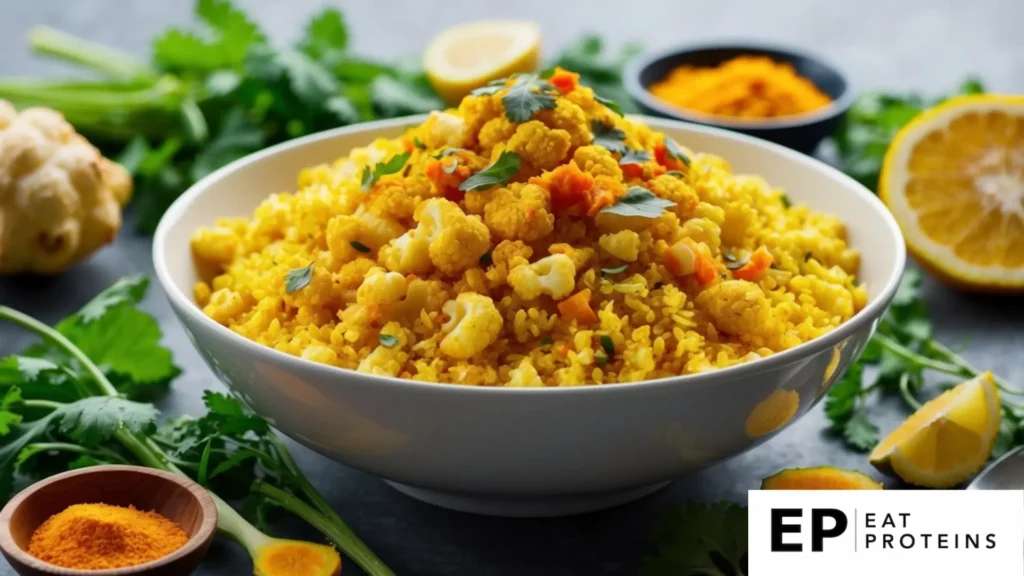
Turmeric cauliflower rice is a simple and nutritious dish I enjoy. Cauliflower serves as a low-carb substitute for rice, and turmeric adds anti-inflammatory benefits.
Making this dish is easy. I start by processing cauliflower florets into rice-sized pieces. This can be done using a food processor or grater.
Here are the steps I follow:
- Heat 1 tablespoon of olive oil in a pan over medium heat.
- Add 1 teaspoon of ground turmeric and stir for about 30 seconds to enhance the flavor.
- Add the cauliflower rice, stirring well to coat it with the turmeric.
- Cook for about 5-7 minutes, stirring occasionally, until it’s tender but not mushy.
- Season with salt and pepper to taste.
This dish pairs well with many meals and can be a tasty side option. It’s not only colorful but also full of flavor, making it a staple in my anti-inflammatory diet.
10. Garlic Spinach Stir-Fry
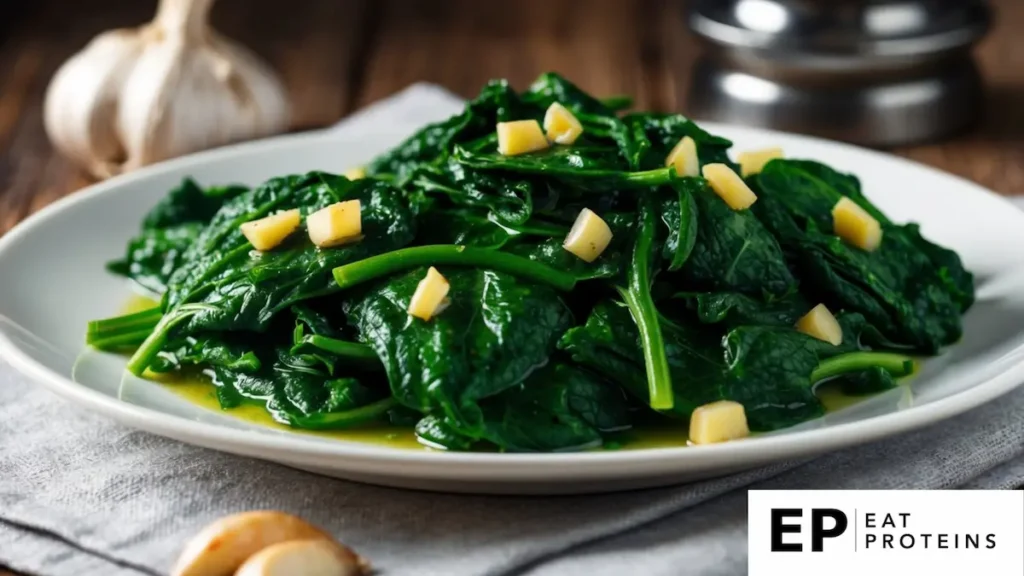
Garlic Spinach Stir-Fry is a simple and nutritious dish. Spinach is packed with vitamins, and garlic adds flavor and health benefits. This meal is quick to prepare, making it perfect for busy days.
To make this stir-fry, I gather the following ingredients:
- 2 cups of fresh spinach
- 3 cloves of garlic, minced
- 1 tablespoon of olive oil
- Salt and pepper to taste
Here are the steps to prepare it:
- Heat the olive oil in a pan over medium heat.
- Add the minced garlic and sauté for about 30 seconds until fragrant.
- Toss in the fresh spinach and stir continuously for 2-3 minutes until wilted.
- Season with salt and pepper, then serve warm.
This dish pairs well with grains or can be enjoyed on its own. If I want to add variety, I sometimes include other vegetables like bell peppers or onions. Making Garlic Spinach Stir-Fry is not only easy but also a great way to boost my meals with anti-inflammatory benefits.
What Are the Benefits of an Anti-Inflammatory Diet?
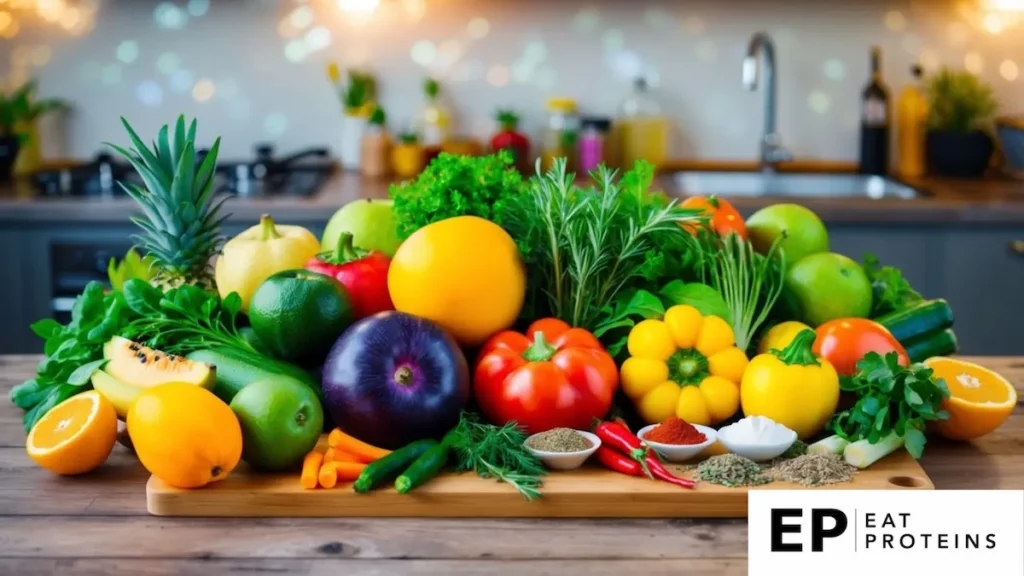
An anti-inflammatory diet can have significant advantages for those looking to improve their health. This approach helps reduce chronic inflammation and can improve overall health in various ways.
What Are the Benefits of Reducing Chronic Inflammation?
I find that one of the main benefits of an anti-inflammatory diet is its ability to lower chronic inflammation. Chronic inflammation is linked to several health issues, such as arthritis, heart disease, and certain cancers. By incorporating foods that fight inflammation, I can support my body’s natural defenses.
Key foods in this diet include:
- Fruits and Vegetables: Berries, leafy greens, and tomatoes.
- Healthy Fats: Olive oil, avocados, and nuts.
- Whole Grains: Brown rice, quinoa, and oatmeal.
These foods are rich in antioxidants and omega-3 fatty acids, which are known to combat inflammation. Over time, I notice a reduction in discomfort and an increase in my overall well-being.
How Does an Anti-Inflammatory Diet Improve Overall Health?
I’ve also seen how an anti-inflammatory diet can enhance overall health. A balanced intake of anti-inflammatory foods can lead to better digestion, improved immune function, and enhanced energy levels.
In my experience, focusing on whole, nutrient-dense foods helps maintain a healthy weight. This is important because excess weight can contribute to inflammation.
Additionally, enjoying foods like fatty fish, nuts, and spices such as turmeric boosts my intake of essential nutrients. These choices support heart health and can lower the risk of many diseases.
In this way, the anti-inflammatory diet promotes not just a healthier body, but also a healthier lifestyle.
What Are the Key Components of Anti-Inflammatory Diets?
An anti-inflammatory diet includes specific foods that help reduce inflammation and promote better health. I focus on the main components that contribute to this diet: fruits and vegetables, whole grains, healthy fats, and lean proteins.
What Role Do Fruits and Vegetables Play in an Anti-Inflammatory Diet?
Fruits and vegetables are essential for an anti-inflammatory diet. They are rich in vitamins, minerals, and antioxidants, which help combat inflammation.
I prefer colorful produce such as berries, spinach, and broccoli. These foods contain high levels of flavonoids and carotenoids. For example, blueberries are known for their antioxidant properties.
It’s beneficial to consume a variety of these foods daily. Aiming for at least five servings of fruits and vegetables can provide essential nutrients. I often add leafy greens to smoothies or salads for added nutrition.
Incorporating them into meals boosts flavor and health benefits. Frozen options are just as good as fresh. They retain nutrients and are convenient when fresh produce is not available.
How Do Whole Grains Contribute to an Anti-Inflammatory Diet?
Whole grains are another vital part of an anti-inflammatory diet. Unlike refined grains, whole grains contain the entire grain kernel, providing more fiber and nutrients.
I choose options like quinoa, brown rice, and whole wheat products. These grains help regulate blood sugar levels, which can reduce inflammation.
Including whole grains in meals can be simple. I often make a quinoa salad with vegetables or a hearty brown rice bowl. Both dishes are filling and nutritious.
The fiber in whole grains also supports digestion and a healthy gut. A healthy gut microbiome is essential for managing inflammation.
Incorporating a variety of whole grains into my diet helps ensure I get all the necessary nutrients.
What Are Healthy Fats in an Anti-Inflammatory Diet?
Healthy fats play a significant role in reducing inflammation. They help my body absorb vitamins and maintain cell structure.
I focus on sources like avocados, nuts, seeds, and olive oil. For instance, olive oil is rich in monounsaturated fats and has anti-inflammatory properties. I often use it in dressings or for cooking.
Including fatty fish such as salmon and mackerel is beneficial too. They are high in omega-3 fatty acids, which are known to help reduce inflammation in the body.
I make sure to limit saturated and trans fats. These can lead to increased inflammation. Instead, I emphasize healthy fat sources in my meals for better health.
How Important Are Lean Proteins in an Anti-Inflammatory Diet?
Lean proteins are a crucial component of an anti-inflammatory diet. They contribute to muscle health and overall well-being without promoting inflammation.
I prefer turkey, chicken, beans, and legumes as my protein sources. These options are lower in saturated fat compared to red meats.
Including beans in soups and salads adds protein without unwanted fats. I find that lean proteins keep me full and satisfied.
Fish, especially those high in omega-3s, such as salmon, are a great option as well. They provide essential fatty acids along with protein.
Overall, I focus on choosing lean protein sources while balancing them with other components of my diet to promote health and reduce inflammation.
What Foods Should You Avoid in an Anti-Inflammatory Diet?
When following an anti-inflammatory diet, it’s essential to know which foods can contribute to inflammation. Two major categories to watch out for are processed foods and added sugars. These items can have a significant impact on your health and may counteract the benefits of eating anti-inflammatory foods.
What Are the Effects of Consuming Processed Foods?
I find that processed foods often contain unhealthy fats and artificial ingredients. Common examples include snacks like chips, frozen meals, and sugary cereals. These foods are typically high in trans fats, which are known to increase inflammation in the body.
Reading labels is crucial. Look for words like “hydrogenated” or “partially hydrogenated” oils. These indicate the presence of harmful fats. Additionally, such foods can lack essential nutrients, further hindering your body’s ability to reduce inflammation.
Opting for whole foods like fruits, vegetables, and whole grains can benefit me greatly. These options are rich in antioxidants and other nutrients that support health and wellness.
How Do Added Sugars Affect Inflammation?
Added sugars are another significant factor that can drive inflammation. I often notice these sugars in sodas, candies, and baked goods. High sugar intake can lead to obesity and insulin resistance, both of which are linked to increased inflammation.
I try to limit my consumption of foods high in added sugars. It’s important to check ingredient lists for sugars that may be hidden under names like high-fructose corn syrup or sucrose.
Instead, I choose natural sweeteners like honey or maple syrup sparingly. Focusing on whole fruits will provide me with sweetness along with essential vitamins and minerals. By being mindful of added sugars, I can better manage my inflammation levels.
How Can You Implement an Anti-Inflammatory Diet?
Transitioning to an anti-inflammatory diet can seem challenging. With thoughtful planning and a focus on variety, I can make this shift both enjoyable and beneficial. Here are some practical tips to help you along the way.
How Does Meal Planning Help with an Anti-Inflammatory Diet?
I find that meal planning is crucial for sticking to an anti-inflammatory diet. I start by setting aside time each week to plan my meals. This helps me choose recipes that are rich in anti-inflammatory foods like fruits, vegetables, nuts, and whole grains.
I create a shopping list based on these meals. This keeps me organized and prevents impulse purchases of unhealthy foods. When I prepare meals in advance, I’m less likely to grab fast food when I’m busy.
I like to batch-cook grains, legumes, and roast vegetables on weekends. This way, I have healthy options ready for busy days. Meal-prepping can make following the diet easier and more convenient.
How Can You Incorporate Variety into an Anti-Inflammatory Diet?
Incorporating a variety of foods is essential in my anti-inflammatory diet. I make sure to include different fruits and vegetables. Each color represents unique nutrients that fight inflammation.
I enjoy trying out new recipes or swapping ingredients in my favorite dishes. For instance, if a recipe calls for spinach, I might use kale or collard greens instead. This keeps my meals interesting and prevents boredom.
I also experiment with herbs and spices like turmeric, ginger, and garlic. These add flavor and boost the health benefits of my meals. By mixing things up, I ensure that my anti-inflammatory eating habits are sustainable and enjoyable.
